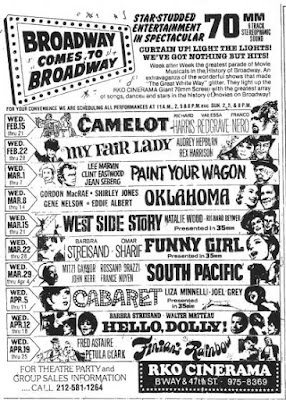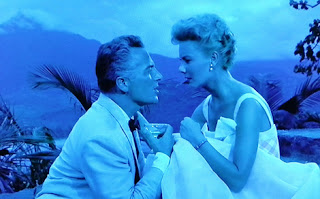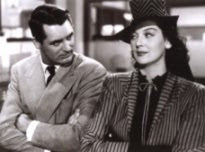George Axelrod is one of those fringe-Hollywood curiosities who exhilarates me more than those names that cause most movie critics to bow and genuflect and the movie industry to bestow its highest honors.
His filmography is the movie equivalent of a slim volume - 12 screenplays and two directorial credits, during a career that spanned 35 years. And much of his allure among cinéastes has everything to do with a single credit - his adroit screenplay for John Frankenheimer's brilliant "The Manchurian Candidate" (1962), based on the Richard Condon book.
It's a rare, presient work that remains ever relevant and modern.
Axelrod got his start writing for radio and live TV in the late 1940s and early '50s before moving to the legitimate theater, making his Broadway-writing debut with "The Seven Year Itch" in 1952, followed by "Will Success Spoil Rock Hunter?" in '55 and "Goodbye, Charlie" in '59. The screen rights to all three were snatched up by one studio, Twentieth Century-Fox.
Of the three, Axelrod was involved in the making of only one. He co-wrote the screenplay for "The Seven Year Itch," released in 1955, with its director, Billy Wilder. Meanwhile, he publicly disavowed the 1957 film of "Will Success Spoil Rock Hunter?" because Fox encouranged its director-adapter Frank Tashlin to switch its backdrop from the publishing industry to television which, at the time, was the chief rival of and threat to movies.
The change actually made the movie more timely and pointed. "Will Success Spoil Rock Hunter?" is regarded as one of the best film comedies of the 1950s. (Sorry, George.) The play starred Jayne Mansfield, who recreated her role on film and who, along with Marilyn Monroe who starred in the movie of "The Seven Year Itch," gave Axelrod an image (whether he wanted it or not) that Hugh Hefner was working overtime to cultivate.

But before his plays found their way it to the screen, Axelrod made his screen-writing debut with Mark Robson's underrated "Phffft!" in 1954. A Judy Holliday-Jack Lemmon vehicle about divorce, it remains surprisingly contemporary and is alive with dialogue that's both snappy and quick. Axelrod gave co-star Jack Carson one particularly memorable monologue on which he lectures Lemmon about the importance of facial hair:
"Grow
a moustache. A moustache is very important, It's all part of the
famous Charlie Anderson Theory on the Efficacy of Face Hair in Dealing
with the Opposite Sex. Sure. Always remember this, Bobby - dames become
unpredictable when faced with a moustache - it both arouses and angers
them. Being as it is a symbol of masculinity, they feel drawn toward
it. And at the same time, because of envy, they feel impelled to
cause its removal. All men should raise moustaches from time to time."
Axelrod followed "Phffft!" and "The Seven Year Itch" with another Monroe film, Joshua Logan's 'Bus Stop" (1956), which he adapted from the William Inge play. In the 1960s, he wrote the screenplays for two Audrey Hepburn films, Blake Edwards' "Breakfast at Tiffany's" (1961) and Richard Quine's "Paris When It Sizzles" (1964); penned another for Jack Lemmon, Quine's "How to Murder Your Wife" (1965), and created and wrote a sitcom for the singular Tammy Grimes called ... "The Tammy Grimes Show" (1966).

His third play, "Goodbye, Charlie," starred Lauren Bacall as a womanizer who is reincarnated as a woman and who has a difficult time reconciling her feelings about women with now actually being one. The role made good use of Bacall's handsome beauty and husky voice. But when Harry Kurnitz adapted Axelrod's play for the 1964 film version, director Vincente Minnelli opted for less obvious casting and brought in a very game Debbie Reynolds to play the slyly butch Charlie.
A risk but it works.
Both "The Seven Year Itch" and "Goodbye, Charlie" have proven to be versatile pieces, having been adapted into European film and TV productions.
There have been two German versions of "The Seven Year Itch" - both titled "Meine Frau erfährt kein Wort"- one filmed in 1970 (and running 100 minutes) and one made in 1982 (running 88 minutes). There is also a TV production filmed in Argentina in 1973 for the series "Alta Comedia."
"Goodbye, Charlie" has been the basis of a 1971 German film," Letzte Grüße, lieber Charlie" (105 minutes), as well as a 1979 French TV version (109 minutes), which retained the American title, filmed for "Au théâtre ce soir," a series devoted to plays. ("Au théâtre ce soir" has also included Gallic productions of "Born Yesterday" and "Boeing Boeing.") In 1985, Suzanne Somers was signed by Twentieth Century-Fox Television for a sitcom version of the material but only the half-hour pilot was filmed.

When he developed some clout, Axelrod attempted a directing career, starting in 1966 with a novelty titled "Lord Love a Duck," which unsparingly satirizes/savages the teenage culture of the '60s with a cast completely in sync with his edgy sense of humor. Roddy McDowell, who was 36 at the time, plays a disreputable high school senior, who takes student Tuesday Weld under wing, becoming her mentor with the goal of helping her get everything she wants, including a collection of cashmere sweaters.

The two stars, who clearly enjoy one another and are having the time of their lives (which is contagious), are surrounded by a cast of delicious misfits - Ruth Gordon, Martin West, Harvey Korman, Sarah Marshall, an uncredited Martin Gabel and, most memorable of all, Lola Albright and Max Showalter as Weld's divorced parents. Showalter and Weld share a particularly hilarious sequence (which could never been filmed today because of its queasiness) in which they go shopping for the aforementioned cashmere sweaters - in colors named Grape Yum Yum, Banana Beige, Lemon Meringue, Pink Put On, Papaya Surprise, Periwinkle Pussycat, Turquoise Trouble, Midnight A-Go-Go, and Peach Putdown.
"Lord Love a Duck," one of those misunderstood films, went nowhere but has sustained a loyal cult following, deservedly so.
Two years later in 1968, Axelrod tried directing again - this time with something more conventional, "The Secret Life of an American Wife," which is less George Axelrod than Neil Simon. Not a bad thing, but not necessarily good either.
The too-often-underused Anne Jackson had one of her infrequent lead movie roles as the wife of a Hollywood agent (Patrick O'Neal) who tries to impress her husband by seducing one of his most important clients (Walter Matthau as an unlikely sex symbol).
In 1971, Axelrod composed his wry memoirs, "Where am I Now When I
Need Me?" He died on June 21st, 2003 at age 81, but had been inactive
for the last two decades of his life. Towards the end of his writing
career, he worked in England and one of his lesser-known credits was
written there - his script for Anthony Page's 1979 remake of "The Lady
Vanishes," starring Cybill Shepherd, Elliott Gould, Angela Lansbury,
Herbert Lom, Ian Charmichael and Arthur Lowe. It's quite good. I'll say more about it later.
Look for a Cinema Obsura.
Note in Passing: Finally, here's a delightfully nutty, Axelrod-solid scene, with Tuesday Weld and Max Showalter, from "Lord Love a Duck." Enjoy!
Regarding Comments:
All comments are enthusiastically appreciated but are moderated before
publication. Replies signed "unknown" or "anonymous" are not
encouraged. Please sign any response with a name (real or fabricated) or
initials. Be advised that a "name" will be assigned to any accepted
post signed "unknown" or "anonymous." Thank you.
~images~
(from top)
~George Axelrod in a publicity shot for "How to Murder Your Wife"
~photography: United Artists 1965©
~Jack Lemmon and Judy Holliday in "Phffft!"
~photography: Columbia Pictures 1954©
~Advertisement for the Broadway production of "Goodbye, Charlie"
~Shots of Tuesday Weld, Roddy McDowell and Ruth Gordon in "Lord Love a Duck"
~photography: United Artists 1966©
~Poster art for "The Lady Vanishes"









































